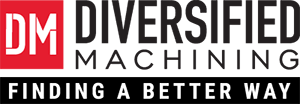Growing Pains for Customer Gains Resting on our laurels isn’t really our style. Diversified...
Massachusetts Machining Company Scaling Up
From Successful to Smaller to Growth: How to Rebuild a Company
Downshifting from a larger scale operation, coming from a complementary industry, my work was cut out for me when I sold my company of almost 40 years and invested with a longtime colleague into his business. As owner and president of Fourstar Connections, I was fortunate to have run a very successful mid-sized cable assembly manufacturing operation for decades. My new business partner, Chet MacDonald, has been running Diversified Machining for just about 40 years as well, and we have had many business interactions over the years, as Fourstar would often contract him for machining jobs.
Though at a smaller scale, Chet ran his shop with the same focus that Fourstar did: expert in his field of machining, quality- and customer-centric, relationship- strong, very personal, one-on-one collaboration, helping people with design for manufacturability (DFM) requirements, with on-time delivery. While I am no longer manufacturing cable assemblies, though coming from a similar model, I could see how and where we could grow Diversified’s machining business. To do this, I had to first realize how we differed. Keep in mind that I grew Fourstar from a small shop, so I was able to trace back to recall the resources I needed to put into place to get me to a position to ultimately sell my business.
strong, very personal, one-on-one collaboration, helping people with design for manufacturability (DFM) requirements, with on-time delivery. While I am no longer manufacturing cable assemblies, though coming from a similar model, I could see how and where we could grow Diversified’s machining business. To do this, I had to first realize how we differed. Keep in mind that I grew Fourstar from a small shop, so I was able to trace back to recall the resources I needed to put into place to get me to a position to ultimately sell my business.
I needed to explore the business model priorities I had been operating from for almost four decades and shift them to more of a start-up mentality. Probably the most crucial piece of this pie was in recognizing the depth and breadth of networks and resources we had built at Fourstar: everything from our talented staff, affiliate relationships with suppliers and vendors, real-time, digital technologies, documented processes and procedures, ISO certification, etc. Chet had all the foundations in place when I came on board—and was running a fine business with satisfied customers—but did not have the tools in place to scale up.
One by one, we deep dove into the challenges we faced, the goals we want to achieve, and have implemented plans to address them. We know that we have a combined strength of working high-mix, low-volume production, with emphasis on new product introduction (NPI) and DFM capabilities. We both still retain very valuable relationships from the span of our careers; some will cross over, some may not (because we are producing different content), but we know our market. As we increase our resources, we can improve our reach and capabilities for the needs of prospects and existing customers.
Tools to Grow
- Technology
Chet was running a great business when I started with him, though it was all manual and could not be scaled. The most logical starting point towards growth was to add technology. His newest equipment, at the time, was 10 years old. In this business, technology changes so rapidly that we knew we needed to make some fast acquisitions: we bought three new machines in the first year.
The next steps involved onboarding other technology to bring us up to speed digitally. So Brian Holman built a new enterprise resource planning (ERP) system from scratch. This software platform provides us with streamlined efficiencies and allows for scaling as we grow with regard to material planning, job tracking, labor standards, among other benefits—which all translate to helping us serve our customers better. We now communicate internally via a file server, so we can share files through our networked computers. This enables us to run the machine work on multiple pieces of equipment. It may sound old- hat to some, but it is taking us in a new, exciting direction with our machining capacity.
Having us online helps us on other levels, too. It’s easy in a small shop to have in-person collaboration, but that doesn’t change the need to rely in the efficiency of emails and real-time communication tools, because—here is the kicker: I don’t have the staff I used to have. I cannot delegate like I used to. There are so many initiatives I want to engage, but don’t have the people (yet!). Everything takes longer, and many tasks exist on a very linear timeline, which can be overwhelming. What that looks like in practice is having a small staff of generalists who are capable of doing multiple tasks. Each of us has a broad variety of capabilities, and as we grow, we will hire specific skillsets. Over time, we will have specialists working with us and will deepen our expertise and industry knowledge—and all the exponential benefits that brings with it.
- ISO Certification
Keep in mind that we already bring our own specialized knowledge and experience to the table, which serves us well as we prepare for ISO certification. Having come from a manufacturing company that was ISO certified, we are already functioning and practicing to many of the standards. As such, we have worked with customers who know and trust our engineering and the quality of our work, and are very satisfied with our machined parts. For those who have an ISO mandate, they have been willing to bear the responsibility for the ISO validation. Still, attaining ISO 9001:2015 is a high priority for us; we are planning on registering by early 2023. We are also adding controls and building all our inspection criteria (along with all the other production/parts details) into the ERP system so we can meet ISO expectations.
- Marketing
Not so obvious, but equally as important, this blog alone is another benchmark of growth. Working with a marketing agency to strengthen our strategies and adjacencies, such as the marketing software platform HubSpot, is helping us to promote ourselves and attract prospects. Certainly, there would be no growth potential due to limited resources, but with the addition of more resources—workforce, equipment, capacity, activating the marketing arm and harnessing the digital platform and knowledge of how to use it—allows us to grow to scale. We can buy all the new equipment we need and hire a team of experts, but without messaging to let people know about our efforts, we wouldn’t move the needle.
Legacy Knowledge Helping Customers
A recent situation occurred with a former Fourstar customer. Through a DFM lens, I had engineered a part for them while with Fourstar, and Diversified had previously machined the part they needed. Unfortunately, this customer had not documented the re-engineered drawings, lost the supplier (the new company owners did not continue business with them), and needed the part run again. They brought the “old/original” drawing to us; I recognized it and knew the build would not be efficient, and would likely not perform well or pass inspection. We addressed it again and provided an engineering re-design. We took it from a three-piece die cut build to one piece, making it a much more efficient and effective from a manufacturing, performance, and quality perspective. We are now machining the part that will meet all their requirements. Value engineering DFM is a strength we offer to customers.
Working With You
Our team works closely with you and will design and build fixtures and jigs, and can work from electronic files, prints, verbal instructions, and sketches. Among the industries we serve are:
- Medical electronics
- Contract electronics manufacturers
- Industrial manufacturers
- Military sub-contract manufacturers
- Robotic manufacturers
- Contractors who need specialized machined parts
We feel assured that the people who Chet, Brian, and I have worked with in the past will have the same confidence in working with us again for their CNC milling, CNC turning, and plastics machining jobs. And we welcome new customers to put their trust in us as contract manufacturing partners for your machined parts. We provide low- to mid-volume, assembly, lathe, and manual work. Allow our 80-plus years of collective experience in prototype and production machining, along with expertise in efficient new product development and introduction (NPD/NPI) and design for manufacturability (DFM) work for you. We’d love to hear from you. Contact us now to get started.



